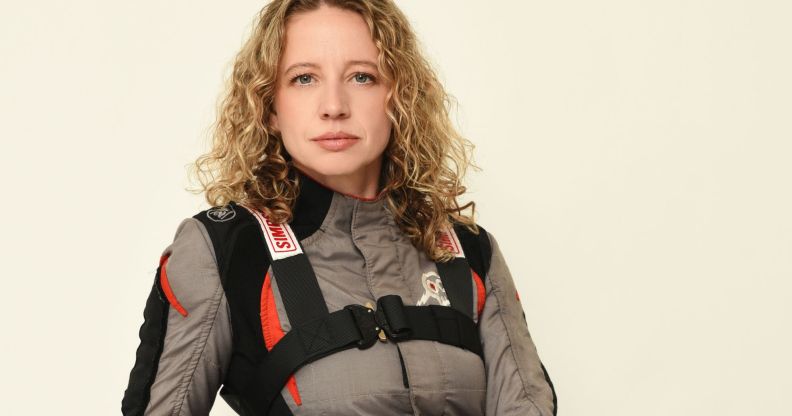Death-defying female stunt driver explains how she rose to the top of male-dominated industry

Zandara Kennedy tried fruitlessly to find other people like her in motorsports. When she couldn’t, she worked to make space for more LGBTQ+ people and women in the industry. (Provided)
Growing up in Canada, Zandara Kennedy spent her time doing trampoline and contortion training, because she dreamed of one day joining Cirque du Soleil.
That dream was cut short after a “pretty serious injury” when she was a teen, but a chance meeting with a stunt guy helped her realise that she could have a career that combined her previous training and growing love of driving.
“It took a lot of work,” she says.
“I don’t think I’m charming in the way some people are, who can network very effectively in an industry that’s all about charisma.
“So I focused on building my skills. My theory was that if I just build my skills to the point that, when I get that opportunity, I so far surpass the expectations of the people giving me that opportunity, they’ll have no choice but to hire me.”
She took her first stunt driving class at age 19 and immediately fell in love.
“I went home and bought an 80s Ford Crown Victoria – the classic cop car you see in every movie from that era – because that’s what we learned on.
“And I beat the s**t out of it practising on weekends, doing all of this stuff. Even though that wasn’t my background, my background was acrobatics, driving and how seriously I was working at it became the thing that set me apart. People started to notice I was doing it.”
The stunt industry can be a tough one to break into, Kennedy says, and there’s a long history of nepotism.

But with her incredible talent she was soon getting work not only stunt driving but as a stand-in, with one of her specialities being fire burns. Her work has been featured on X-Men, Deadpool, Supernatural, Fear the Walking Dead and XXX.
She says her drive to keep pushing her skills meant she took any money she made to reinvest into driving, which eventually took her to the drift course.
“I always joke it was like trying heroin for the first time because the reality is I’ve lost all rationality,” she says.
“The goal was to become the best stunt driver I could become, and somewhere along the way I started doing the stunts to pay for the drifting.”
Drifting is a motorsport where drivers intentionally oversteer to drift around corners – it was made famous by the third Fast and Furious film, Tokyo Drift.
Kennedy won a rare drifting license in a competition – on average, three people per competition series are awarded a license, and she became the only Canadian woman in pro drifting,
She explains: “It had never been my plan to compete in professional drifting.
“But as the only Canadian woman to do it, I felt like a decision had been made for me.
“To have such an opportunity and not take it seemed wasteful because who knows when the next woman would come along to do it, especially since at the time and even last year only two women were competing in Formula Drift total.”
Zandara Kennedy building a community as the first (and only) openly LGBTQ+ athlete competing in professional drifting
With such a limited pool, Kennedy has found herself standing as the only out LGBTQ+ pro drifter, something which has been isolating.
“I Googled everything you can think of gay race car drivers, gay motocross racers – like women, men, non-binary, anyone who was a little bit more part of the community,” she says.
“I felt so much of an outsider.”
She eventually joined Racing Pride, a movement to positively promote LGBTQ+ inclusion through motorsport, to spread awareness for the queer community in racing. On top of her work with Racing Pride, Kennedy puts on women’s only events or events for women of colour that focus on stunt work
Kennedy has found allies within the motorsports world as a result, though she remembers one person who said they didn’t want their “logo on the same car as a Pride flag”, which brought her to tears.
“That’s the whole thing we’re afraid of – when you walk into a space and you don’t know if you’re welcome, you don’t know how people are going to react if you are who you are,” she says. “That’s such a scary thing.”
She continues: “The good ending to that story is that person called me back the next day and said, ‘I don’t care. I like working with you. I respect you, and I want to work with you.’
“But I still had to go through that rejection. When I look around, there are few enough women in motorsports – across all the motorsports – and many of them are marketed by their sexuality, not by their talent, their competence or they come from a family with motorsport background or a ton of money.
“What’s important for me is I want people to know that if this is something you love, you can do it. You don’t have to be born into the right family. You don’t have to have that history. There’s a place for you here.”
How did this story make you feel?

